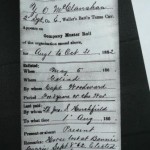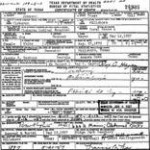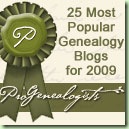Latest News
Genealogy for Halloween: A Treat from Genealogybeginner.com
October 27, 2011 by ramona
Filed under Articles, Latest News
 Genealogy and Halloween go together like “Trick or Treat”. After all, who is more interested in the spirits of the past than your average ancestor hunter. If you needed any more proof of that, you would not have to go farther than a visit to some of the preeminent genealogy sites and blogs, such as GeneaBloggers or Genealogy.com.
Genealogy and Halloween go together like “Trick or Treat”. After all, who is more interested in the spirits of the past than your average ancestor hunter. If you needed any more proof of that, you would not have to go farther than a visit to some of the preeminent genealogy sites and blogs, such as GeneaBloggers or Genealogy.com.
Here is a look at how the genealogy community is celebrating this holiday in spooktacular style
A Halloween themed Radio show
Set your calendar for Friday October 28 to catch “Haunted by Ancestors – A Genealogy Halloween Special!” presented by GeneaBloggers at: http://www.blogtalkradio.com/geneabloggers/2011/10/29/haunted-by-ancestors–a-genealogy-halloween-special. The show will feature professional genealogist Henry “Hank” Jones Jr., who will be speaking on his book “PSYCHIC ROOTS: SERENDIPITY & INTUITION IN GENEALOGY”. Other guests included in the October 28 radio show are Paul J. Bunnel, genealogist slash certified Ghost Hunter and Melinde Lutze Byrne, vice president of the American Society of Genealogists and former skeptic. The show is moreover proclaiming a mystery guest, someone who will make an important announcement asserted to be of great interest to the genealogy community. GenealogyBloggers Radio certainly promises an entertaining evening of bone digging fun.
Historic Halloween pranks
Over at Genealogybank you can find an entertaining post titled “Halloween ‘Tricks’—One Subtle, the Other a Blast”. Offering an interesting historic look at the “trick” side of this well-loved celebration, Genealogybank has tracked down a couple of old newspaper articles based on the past hijinks of Halloween tricksters. Sharing some of the fun genealogists can find in searching newspaper archives and giving us a very instructive read.
From the graveyard
A Spooky Genealogy: A Cemetery Find is what you will find when you go Trick or Treating at the Ancestor chase Blog. A visit to this site will give you the chills as they recount the tale of a strange and unexpected genealogy discovery. One that was perchance initiated from beyond the grave, by those lost from the family tree record.
Genealogy.com is joining in the Halloween amusement with a fantastic article on cemetery searches. The article covers Getting Started with Cemetery Records as well as Cemetery Records and Gravestones. In addition to this wonderful information, there are some great tips on finding additional sources for your cemetery search.
Show of your generations
MyHeritage.com is holding a Halloween Family Photo competition, what they are looking for are creative and original photos of families dressed up in their Halloween best. Uploading your favorite family Halloween picture, old or new, onto their Facebook page could win you a premium subscription at MyHeritage.com. Contest entry ends November 1, 2011. For more information, give them a visit.
Story time
If spooky stories of generations past are what you have in mind this Halloween, then Ancestry.com should be on your list with a message board dedicated solely to scary ancestral tales.
In the news
A week of Family Tree Halloween merriment would not be complete without this wonderful headline maker from The Associated Press.
Prince Charles linked to Dracula
“LONDON The truth is out: Prince Charles is related to Vlad the Impaler.
The heir to the British throne says he is related to Vlad the Impaler, the cruel 15th-Century Romanian warlord who helped inspire Bram Stoker’s 1897 vampire novel “Dracula.”
For the complete story visit: http://www.thespec.com/whatson/celebrity/article/615644–prince-charles-linked-to-dracula
Wrap up
Of course, this could not end properly without a Samhain Salute from Genealogybeginner.com
Have a Safe and Happy Halloween!
Family History and Food: Genealogy Beginner for Blog Action Day
October 16, 2011 by ramona
Filed under Articles, Genealogy for Beginners, Latest News
 Today is Blog Action Day and the subject is food. This year’s subject puts me in mind of how our gastronomic tastes and cooking practices have changed from those of our not so distant ancestors. Remembering some of the dishes grandma prepared makes me wonder if perhaps my forebears would have as poor an opinion of my food choices, as I have had of theirs. In my youth, dishes like Blood Pudding, Headcheese and Haggis would elicit a fight or flight response when encountered at the dinner table. Then again, only imagination can satisfy what Great, Great, Great Grandfather McCallum would have though of the mechanically deboned chicken nugget.
Today is Blog Action Day and the subject is food. This year’s subject puts me in mind of how our gastronomic tastes and cooking practices have changed from those of our not so distant ancestors. Remembering some of the dishes grandma prepared makes me wonder if perhaps my forebears would have as poor an opinion of my food choices, as I have had of theirs. In my youth, dishes like Blood Pudding, Headcheese and Haggis would elicit a fight or flight response when encountered at the dinner table. Then again, only imagination can satisfy what Great, Great, Great Grandfather McCallum would have though of the mechanically deboned chicken nugget.
Factors such as geography, availability and technology have unarguably contributed to a drastic change in diet and menu within the last 100 years.
Food and family history
The evolution of food from our distant and not so distant past to our modern kitchens can be a great source for family history stories. Enriching your families narrative with traditional recipes then and now in a cookbook, is a superb way to explore past generations. It is also a great way to preserve recipes and traditions for future generations.
Cook up some family stories
Writing on the subject of your families historic cookery does not have to be limited to recipes. Did you ever wonder what it was like to cook on a coal and wood stove, or think about what your life would be like without a refrigerator or microwave? Our forebears regularly grew gardens and raised animals for food. They hunted, fished and took advantage of nature’s bounty of wild berries, nuts and fruits. Unlike us, they did not have supermarkets and they certainly did not have access to modern food preservatives. Asking questions about how they prepared food to be stored over winter months, where they stored it and what types of containers they stored it in, are well worth including.
Wrap up
In these ordinary details of our past generations, we often find tales of courage and survival, not to mention healthy lifestyles. We are coming full circle and current trends such as the 100-mile diet, organic food and urban gardens, should alert us to the fact that we just might learn something from them.
Free Genealogy Search: 1940 US Census Returns Go Live April 12, 2012
October 12, 2011 by ramona
Filed under Articles, Latest News, Public Records
 A visit to the National Archives genealogy resources page evokes a subtle sense of excitement, as the counter ticks down to the April 2, 2012 release of the 1940 US census returns. These important records will be accessible through public access computers at Nara facilities on a national level. They can also be conveniently accessed through the internet from your personal computer. Better yet, it is free of charge. The 1940 census is the 16th Federal Population Census of the United States and the census day was April 1.
A visit to the National Archives genealogy resources page evokes a subtle sense of excitement, as the counter ticks down to the April 2, 2012 release of the 1940 US census returns. These important records will be accessible through public access computers at Nara facilities on a national level. They can also be conveniently accessed through the internet from your personal computer. Better yet, it is free of charge. The 1940 census is the 16th Federal Population Census of the United States and the census day was April 1.
The questionnaire for this census was a double-sided form that afforded space for 40 entries. There were also two additional lines for the five percent sample questions.
New questions added
Many of the questions answered on the 1940 returns are customary to census questionnaires. However there are several new questions added that are likely to provide clues of great value to your genealogy research. For instance, the 1940 census asks for the name of the person providing the information as well as the birthplace of that person’s mother and father.
Some other interesting questions asked on the 1940 census include:
• Whether the home of the enumerator is owned or rented, as well as the value of the home
• Whether there are any persons currently absent from the household
• Highest completed level of education
• It asks for a specific profession such as salesman, music teacher or laborer etc
• Whether the person is a veteran of the US military or the wife, widow or child of a veteran
• The earliest language spoken at home during childhood
Of a woman’s marital status it asks for the number of times a woman has been married, her age at the time of her first marriage and the total number of children born to her. (Excluding stillbirths)
Research strategies
For those of you who are already eagerly anticipating your research of the 1940 returns. Here are a few strategies to help you get the most out of your investigation. At the top of this list is the knowledge that you will not be able to conduct searches by name, as there will be no name index available when it first opens up. To locate your ancestor, you are going to need their address as well as the enumeration district in which it was located. It may be a good idea to start gathering some of this data now.
In order to find the addresses of the forebear(s) you will be researching. You can start looking them up in city directories. These directories are usually available in your local library, so initiate your inquiry there. If you have already found your predecessors in the 1930 census, use it as a starting point for your 1940 census searches. Another excellent resource for tracking down locations is the WWII draft records.Should you still be having trouble locating the enumeration districts you need? Try the 1940 enumeration district, census maps, as they should contain the district numbers.
It is important to note, that maps may not be available for all towns; in this case, looking at county maps is the next step.
Links to enumeration district finding aids:
• Geographic Descriptions of Census Enumeration Districts
• Enumeration District Maps
• 1940 City Directories at NARA
• Use Stephen P. Morse’s Search engines to locate Census Enumeration District Numbers
This information should get you off to a great start. However, should you want a little more assistance there is a very informative guide available at the NARA Website. Before you leave, grab the table for deciphering the codes used in the 1940 census. Print it out and keep it with your preparation materials for an organized search later. This will give you plenty to do while waiting for April 2, 2012 to arrive.
For more information on this and other great genealogy resources visit: National Archives and Records Administration.
Family Search Adds Millions of New Records in September of 2011
September 30, 2011 by ramona
Filed under Articles, Latest News, Public Records
On September 7, 2011, Family Search once again enriched the genealogy community by adding millions of new records to its database. Included in the new additions are records from the US, Canada, Mexico, England and South Africa. Let us take a little closer look at this new genealogical treasure trove. The majority of the US records focus on Union and Confederate soldiers who served in the American Civil War and include records from Alabama, Arkansas, California, Delaware, Florida, Georgia, Kentucky, Louisiana, Maryland, Mississippi and Missouri.
once again enriched the genealogy community by adding millions of new records to its database. Included in the new additions are records from the US, Canada, Mexico, England and South Africa. Let us take a little closer look at this new genealogical treasure trove. The majority of the US records focus on Union and Confederate soldiers who served in the American Civil War and include records from Alabama, Arkansas, California, Delaware, Florida, Georgia, Kentucky, Louisiana, Maryland, Mississippi and Missouri.
In addition to the Civil War Records, you will also find.
Applications for headstones for military veterans, 1925-1941
This collection contains images of the applications of the Cemetarial Division of the Quartermaster General. Most of these records are for Civil war veterans although a few do cover earlier wars.
Index of passenger arrivals in the gulf ports, 1820-1874
In this set of records, you will find a card index for passengers that arrived in 70 ports along the Atlantic and Gulf Coasts. Sadly, there are none included from New York.
Records of national homes for US disabled volunteer soldiers, 1866-1938
This collection contains a wealth of historical registers for veterans admitted to 12 regional homes. Information in these records include (but are not limited to) Company, regiment, marital status, birthplace, date and cause of death.
Records of confederate prisoners of war, 1861-1865
An incredible 427 images of volumes are contained in this record set from the War Departments office of the Commissary General and the Surgeon Generals office.
Index to the Pension Application Files, for the War of 1812, 1812-1910
A collection containing the soldier’s name, military service information and widow’s name.
Canadian notorial records
Notarial records, distinct to Quebec Canada; are a record of private agreement taken by a notary and are a legal and binding contract. Notary records include marriage contracts, leases, inventories and wills.
Quebec notarial records, 1800-1900
In this collection you will find the records arranged by geographic location, notary and time period.
England miscellaneous records
A collection of records from the Northumberland Archives Service. This miscellaneous assembly includes Parish Registers, Electoral Registers and Nonconformist records.
Mexico
Mexico, Guanajuato, Catholic Church Records, 1576-1984. Marriages and Baptisms from the Catholic Parishes in the state of Guanajuato, Mexico are kept in this collection.
Mexico, México Estado, Civil Registration, 1861-1941. An assortment of Civil registrations, (births, marriages and deaths), from the state of México Edo, Mexico.
South Africa
South Africa, Dutch Reformed Church Registers, 1660-1970. You will find an index and images of marriages and baptisms along with records of membership in the Dutch Reformed Catholic Church. This collection covers the locations, Namibia, Cape of Good Hope province and Transvaal province
The records contained in all collections are being published in full, as images become available.
For more on these new record additions visit Family Search.org
Misadventures in Indexing
April 14, 2011 by Chris
Filed under Articles, Genealogy for Beginners, Latest News
 Fine. I admit it. My indexing numbers are nowhere as big as Renee Zamora’s. That’s not to say I don’t find it as meaningful. In fact, my problem is that sometimes I find it too meaningful. Take last week. I made the mistake of taking a batch of Louisiana Death certificates. Soon I was so drawn into these people’s lives, that it took all week to get one batch done. I started on the first certificate. Cause of death? Drowning. How sad. How old was this person? A ten year old boy. Wow; that is sad. Why did someone write “refugee” at the top?
Fine. I admit it. My indexing numbers are nowhere as big as Renee Zamora’s. That’s not to say I don’t find it as meaningful. In fact, my problem is that sometimes I find it too meaningful. Take last week. I made the mistake of taking a batch of Louisiana Death certificates. Soon I was so drawn into these people’s lives, that it took all week to get one batch done. I started on the first certificate. Cause of death? Drowning. How sad. How old was this person? A ten year old boy. Wow; that is sad. Why did someone write “refugee” at the top?
Next certificate. Also said “refugee” at the top. Cause of death? Drowning! Wait a minute. Same name? No, this one was North Hudson’s five year old name sake. Same date? Yes, 8 July 1927. Both in Port Barre, St. Landry Parish. Wow. Opelousas is crossed out and Porte Barre written in. Wonder what happened.
Third and fourth certificates. Also refugees who drowned on 8 July 1927. Both named Hudson. North Hudson was here again, as informant. Does that mean he had to identify the bodies?
Fifth, sixth, seventh. All children of Delphine Thornton, ages 13, 9 and 5. All 8 July 1927 in Port Barre. Oh, my goodness. She lost three children in whatever happened.
What did happen? It didn’t take very long before Google had uncovered the Great Flood of 1927. The Mississippi had overflowed her banks during the spring runoff. Displaced “refugees” were evacuated to neighboring communities.
I’m still unclear of all the goings on, but the flood waters seem to have lasted for months. On 8 July 1927 I think the levee protecting Port Barre failed. It fell to the medical examiner in Opelousas to perform the terrible last reuniting of lost family members. I found myself feeling awkward, standing in the back, an unbidden guest, witnessing this pervasively private moment. Then I thought that perhaps, if caring members of these families ever come looking for them, my indexing will easily bring them to this very same spot, let them see what I am seeing. I will have quietly slipped out the back, letting loving family unite again across time. And grieve. And remember.
(This posting is from The Ancestry Insider.)
50 Best Blogs for Genealogy Geeks by Online University
May 20, 2010 by Chris
Filed under Articles, Genealogy for Beginners, Latest News
 Genealogy Beginner was rated within the top 50 Best Blogs for Genealogy Geeks online by Online University. We’re proud to share the spotlight with some great fellow genealogy bloggers. You can check out the full list at Online University. They break the list up into four key sections: General, Specific Research Projects, Libraries and Resources, News.
Genealogy Beginner was rated within the top 50 Best Blogs for Genealogy Geeks online by Online University. We’re proud to share the spotlight with some great fellow genealogy bloggers. You can check out the full list at Online University. They break the list up into four key sections: General, Specific Research Projects, Libraries and Resources, News.
The number one blog for each category included:
- General – DearMYRTLE’s Genealogy Blog: Myrtle helps those looking to piece together their family histories learn about the genealogy process.
- Specific Research Projects – AnceStories: The Stories of My Ancestors: Follow this blogger’s journey to learn how to go about your own research project.
- Libraries and Resources – Ancestry.com Blog: Ancestry.com keeps readers and site users updated on genealogy and online research.
- News – GenealogyBlog: This is a daily news blog for genealogy enthusiasts, which outlines special events, collections, research tips, and more.
Thanks again to the great people doing good work over at Online University. We appreciate the mention.
Top 25 most popular 2009 genealogy blogs
May 11, 2009 by Chris
Filed under Articles, Latest News, Public Records
 ProGenealogists recently announced their “25 Most Popular Genealogy Blogs for 2009” awards. We are very honored to be part of this group. A glance through the other blogs on the list is truly humbling. It’s even more humbling to read ProGenealogists announcement, noting that “a Google search for genealogy blogs currently results in nearly half a million options, with over seven times that number for ‘family history’ blogs.” I’m not certain how to do a Google search that returns the number of blogs, but to search blog posts, try http://blogsearch.google.com .
ProGenealogists recently announced their “25 Most Popular Genealogy Blogs for 2009” awards. We are very honored to be part of this group. A glance through the other blogs on the list is truly humbling. It’s even more humbling to read ProGenealogists announcement, noting that “a Google search for genealogy blogs currently results in nearly half a million options, with over seven times that number for ‘family history’ blogs.” I’m not certain how to do a Google search that returns the number of blogs, but to search blog posts, try http://blogsearch.google.com .
At the time I wrote this article a search for the word genealogy returned 857,000+ blog posts containing the word genealogy. A search for “family history” (including the quotes), returns 674,000+ posts.
Subscribe to new Google Search results
The search results page contains one of my secrets for uncovering news stories that you won’t see on the other genealogy news sites. You can subscribe to the results of your blog search by clicking one of the options in the left margin under the heading, “Subscribe.” This will give you an email or news feed of all the new results for your search. That’s only 6,600+ articles you’ll have to read each day to cover all blog posts with either the phrase “family history” or the word “genealogy.” Better yet, let your favorite genealogy news blogs shift through all those posts while you use the email option, called a Google Alert, to set up a Internet-wide sweep for new information on those ancestors you’re trying to find!
And thank goodness the President’s choice for new First Pet is done. Several months ago Google changed their search algorithm. My Google alert for FamilySearch started returning results containing “…First Family searches for dog…” To prevent this behavior, include quotes around words you don’t want Google to break into separate words. But I digress…
Measurement Challenges
Choosing the 25 most popular genealogy blogs had special challenges not encountered when measuring the 50 most popular genealogy websites.
“Many people read blog entries through RSS feeds and other means and seldom actually visit the blog’s website,” according to Kory Meyerink, noted genealogist and vice president at ProGenealogist. Instead of website traffic, ProGenealogist turned to Technorati rankings. Even this alternative proved problematic, as Technorati doesn’t include Dick Eastman’s popular online blog/newsletters. This led ProGenealogist to include other factors:
Hundreds of genealogy blogs were evaluated based on their overall content, Technorati rating, and industry experience. Due to the ever-changing nature of the blogosphere and the authority basis of Technorati rankings, it is anticipated that this list will change frequently.
When I first started blogging years ago (has it really been that long?) I found my Technorati authority rating changed so erratically, I couldn’t stand to follow it. Since I seem to be in widget-mode of late, here’s a widget that displays my authority rating in real time:
View Ancestry Insider authority
Like other widgets I’ve posted lately, it is likely you won’t be able to see it (adjacent to “View Ancestry Insider authority”) if you read this article in your email or news reader. View this article online (click here) to see the widget.
The Technorati Authority of a blog is a count of the number of other blogs that have posted links to it during the previous six months. Since other winners of the most popular blogs award have increased my authority by posting the list of winners, I’m honored to return the favor. They are:
- About.com Genealogy (Kimberly Powell)
- Eastman Online Newsletter* (Dick Eastman)
- Genea-Musings (Randy Seaver)
- Creative Gene (Jasia)
- DearMYRTLE (Pat Richely)
- AnceStories (Miriam Midkiff)
- Genealogue (Chris Dunham)
- footnoteMaven (Anonymous)
- Genetic Genealogist (Blaine Bettinger)
- Tracing The Tribe: Jewish Genealogy Blog (Schelly Talalay Dardashti)
- GenaBlogie (Craig Manson)
- Olive Tree Genealogy Blog (Lorine McGinnis Schulze)
- Steve’s Genealogy Blog (Stephen J. Danko)
- Ancestry.com (Juliana Smith)
- TransylvanianDutch (John Newmark)
- GenDisasters (Stu Beitler)
- Genealogy Insider @ FamilyTree (Diane Haddad)
- Think Genealogy (Mark Tucker)
- California Genealogical Society and Library Blog (California Genealogical Society)
- The Genealogy Guys (George G. Morgan and Drew Smith)
- CanadaGenealogy, or, ‘Jane’s Your Aunt’ (Diane Rogers)
- Ancestry Insider (Anonymous)
- GenealogyBlog (Leland Meitzler)
- Ancestor Search Blog (Kathi)
- Genealoge (Hugh Watkins) /its a tie!/
Legacy News (Legacy Tree Software) /its a tie!/
(This posting is from The Ancestry Insider. Click the link to view the full article from its original source.)
1911 Census for England now completely online
April 11, 2009 by Chris
Filed under Articles, Latest News, Public Records
In the ev er changing world of online genealogy you have to keep an eye peeled for the latest BIG NEWS! Today’s top story: The 1911 census for England has finally been uploaded. Any one who has been looking for their Scottish ancestors down south will be thrilled to know that the England’s 1911 census is now available through FindmyPast.com at www.1911census.co.uk
er changing world of online genealogy you have to keep an eye peeled for the latest BIG NEWS! Today’s top story: The 1911 census for England has finally been uploaded. Any one who has been looking for their Scottish ancestors down south will be thrilled to know that the England’s 1911 census is now available through FindmyPast.com at www.1911census.co.uk
The next 1911 censuses in line for release are for:
- The Isle of Man
- All Welsh counties
- The Channel Islands
- Royal Naval ships at sea and overseas military establishments.
There is however a wait ahead for the Ireland 1911 census to be released, as it is a bit behind schedule. No word has been heard to explain the holdup from www.census.nationalarchives.ie. We will keep checking with Chris from Scotland’s Greatest Story as he promises to keep us informed and let us know as soon as he hears anything.
Ancestral Trails
January 23, 2009 by Chris
Filed under Articles, Latest News, Public Records

…
Where to Next?
Blank Family Tree with Step-by-Step Instructions
…
Make a Family Tree with the “Ancestry Toolbar”
December 7, 2008 by Chris
Filed under Articles, Blank Family Tree, Latest News
 There are a lot of great resources out there to help you make a family tree. One of which is the great work done over at Ancestry.com. Recently the Ancestry Insider wrote a great review of how to use Ancestry.com to make a family tree. Specifically, they focus on how you can make a family tree with much more ease than would otherwise be the case by using the browser toolbar.
There are a lot of great resources out there to help you make a family tree. One of which is the great work done over at Ancestry.com. Recently the Ancestry Insider wrote a great review of how to use Ancestry.com to make a family tree. Specifically, they focus on how you can make a family tree with much more ease than would otherwise be the case by using the browser toolbar.
(See bottom of post for original article that I’ve summarized below)
Continue reading “Make a Family Tree with the “Ancestry Toolbar”” »
